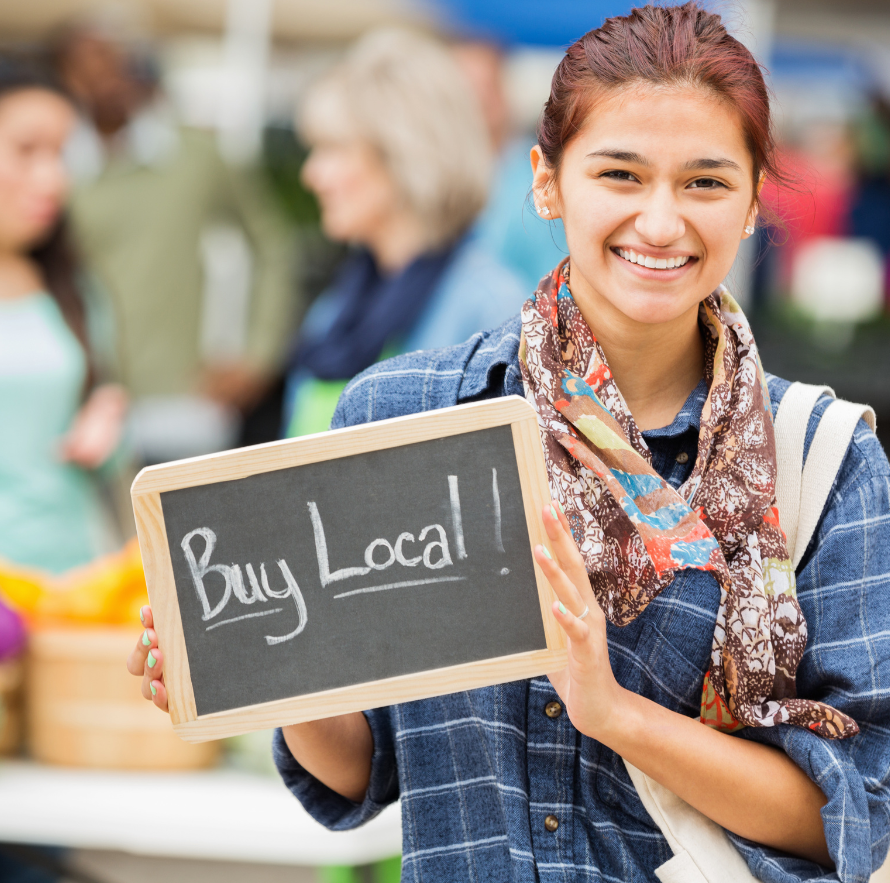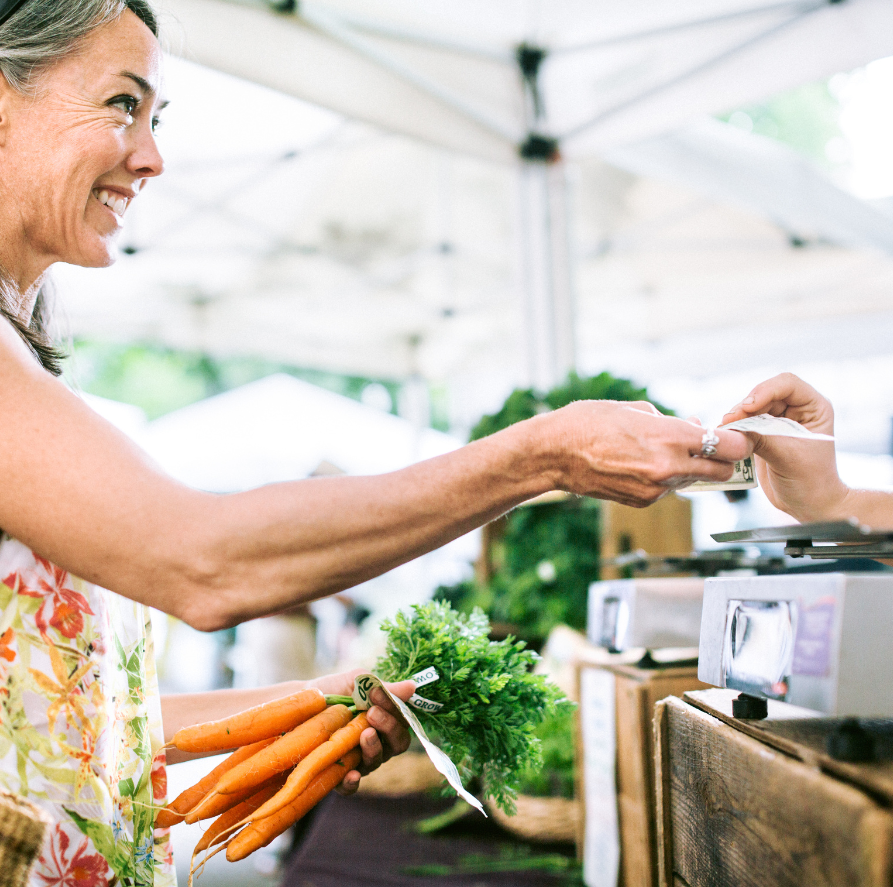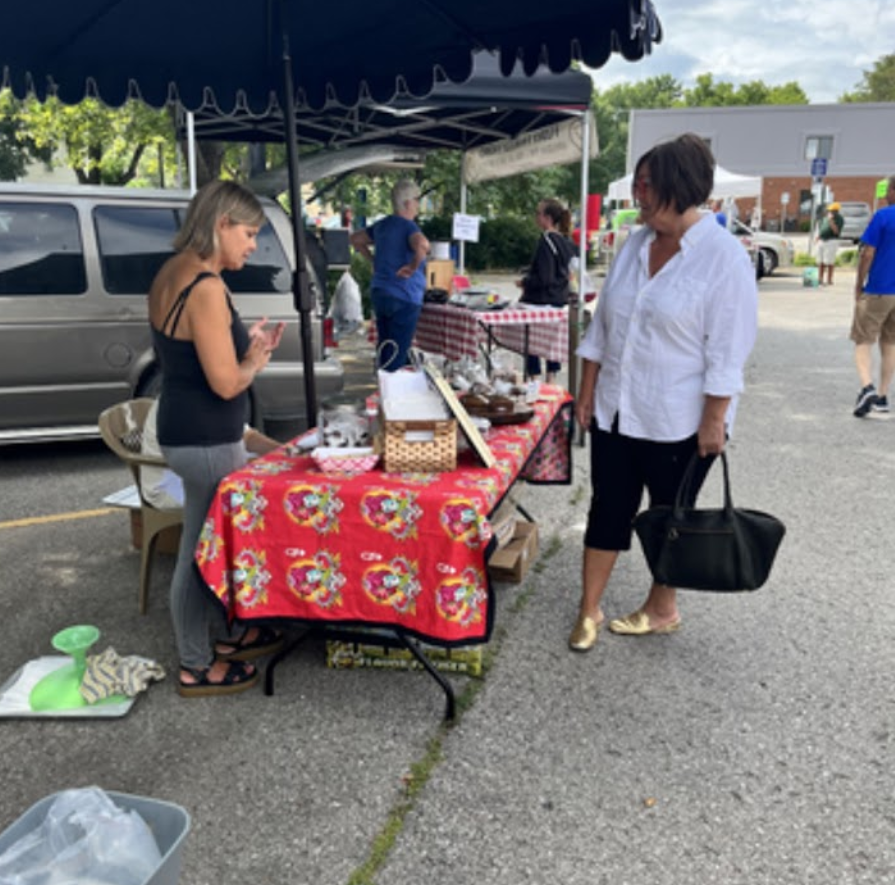Are you curious about the possibilities of selling baked goods at the farmer’s market?

Selling baked goods at the farmer’s market is a fantastic opportunity to connect with your community and earn extra income.
In this comprehensive guide, I’ll walk you through everything you need to know to get started and succeed in this bustling marketplace.
Can I sell my home-baked goods at the farmer’s market?
The big question most new bakers want to know is whether or not they can sell baked goods they make in their homes at the farmers market. Here’s the good news: the market isn’t just for fresh fruit and vegetables anymore!
Who can sell at local markets?
These days, there is a big trend towards artisan, small-batch, local food items. Take a stroll through a farmer’s market and you’ll see:
- Coffee roasters
- Hand-made body care products
- Gourmet sauces and spices
- Specialty homemade food products
- Cottage foods bakers
The farmer’s market scene has seen a huge increase in artisan vendors and has become a thriving marketplace for launching a small business. It’s the perfect fit for a cottage food or home-based baker.
Before you dive in though, you’ll want to be a legally operating home bakery following your state cottage food laws. Keep reading to learn how…
Legal and Regulatory Considerations
Do you need a license for selling baked goods at the farmer’s market?
You typically need to be a licensed cottage food business to sell baked goods at the farmer’s market. Each state has its own regulations regarding cottage food operations, so it’s important to understand and comply with the local regulations in your area.
How to become a cottage food business
Cottage food laws vary by state but generally cover the following:
Types of Products: Cottage food laws outline which types of food can be made and sold under these regulations. They typically exclude the use of hazardous food ingredients like dairy and meat.
Production Location: These laws specify that cottage foods must be prepared in a cottage food kitchen or similar non-commercial space, rather than in a commercial food establishment.
Labeling Requirements: Cottage food producers must adhere to food labeling guidelines, including listing ingredients, and allergen information, and stating that the product was made in a home kitchen.
Registration or Permitting: Cottage food producers are typically required to register their operations with the state or local health department and obtain any necessary permits or licenses.
To start a cottage food business, producers must know and follow their state government’s rules for cottage food operations. This keeps things legal and ensures food safety.

Becoming a Vendor at the Farmer’s Market
Becoming a vendor at the farmer’s market involves several steps. Start by contacting your local market manager and familiarizing yourself with their application process, fees, and product requirements.
Your farmer’s market may have a website or a download guide to becoming a vendor. You’ll want to get a copy of that and read it thoroughly.
They’ll cover things like:
- Application process
- Licenses
- Insurance
- Fee’s
- Product requirements
Every market is different, so make sure you get your information from each market you want to participate in.
Farmer’s market season usually runs from April to October. The waitlist can be long, so start making plans early for the following season. Some markets don’t have a long wait though, so it’s always worth asking if they still have spots available for the current season.

Assessing the Market’s Potential
Is selling at the farmer’s market worth it?
The next question you may have is if selling at the farmer’s market is worth it. To decide that you’ll need to know the following things:
- The cost to participate
- The number of baked goods you can make
- How much you would earn if you sold everything
After you answer these questions, you can do some simple math and decide for yourself if it’s worth it.
The general feedback from home-based bakers is that it is definitely worth it for them because of the number of customers they can have on any given day.
For big farmer’s markets: You’ll likely get plenty of foot traffic and exposure to lots of new customers each week.
For smaller farmer’s markets: You may still do well since smaller markets usually have lower fees and less vendor competition.
How much money can you make selling baked goods at the farmer’s market?
Imagine you’re planning to sell your homemade cookies at the farmer’s market. Exciting, right? But how do you figure out if it’s worth it financially?
Here’s a simple way to calculate it:
- Add Up All the Costs: List all your market-related expenses—like the booth fee, insurance, and travel costs. Let’s say they total $50 per week.
- Figure Out Your Needed Sales: Calculate how much you need to sell to make a profit, including paying yourself for your time. For instance, if you work 30 hours and pay yourself $12 an hour, that’s $360.
- Consider Your Production Capacity: Think about how many cookies you can bake in your kitchen each week. Let’s say it’s 50 dozen cookies.
- Do the Math: If you sell all your cookies, you’d make $1,250. Subtract your market fees ($50) and ingredient costs (25% of sales price, so $312.50), leaving you with $887.50. Then subtract your pay ($360), leaving you with a $527.50 profit.
With this example, you’d cover your costs, pay yourself, and have more than $500 profit remaining.
Adjusting factors like baking more cookies or charging a higher price can further increase your profit.

Market Preparation and Setup
Selling your baked goods at a local farmers’ market is a great way to talk directly with your customers. You will get lots of foot traffic from people who don’t yet know you. so you’ll want to make sure your booth display makes a great impression.
Tips for a Stellar Bakery Booth Display:
Worried about how to set up your booth? Here are some tips to help you:
- Utilize Vertical Space: Make use of vertical space to catch the eye of passersby. Elevate your items off the table to ensure they’re visible at eye level. Remember, “eye level is buy level.”
- Showcase Your Brand: Don’t forget to promote your brand! Have business cards and printed menus readily available to inform customers about your offerings. Make sure to include contact information and details on how to reorder your products.
- Add a Pop of Color: Stand out from the crowd by incorporating your brand’s colors into your booth display. Using a consistent color scheme throughout your setup can make it more memorable and draw attention to your products.
Bakery Display Essentials:
After years of selling at markets, I’ve curated a list of easy setup supplies for a successful market experience. You can find these items in my Amazon shop:
- Folding Table
- Spandex Table Cover
- Printed Banner
- Wooden Crates
- Table Decor
- Acrylic Sign Holders
- Baskets for Products
- Cash Box
Visit my Amazon shop for these essential bakery display items.

Packaging Tips for Farmers’ Market Sales:
Here are some suggestions for packaging your products for the market:
- Cellophane Bags: An easy way to present your products is by using clear cellophane bags. They showcase your items, making it convenient for customers to see what they’re buying and fit into their shopping totes or baskets.
- Promote with Labels: Labels are vital for providing crucial details to customers, such as your business name, ingredients, allergens, and contact information. They also serve as a powerful promotional tool, allowing you to include a QR code or share your social media handles.
- Eco-friendly Packaging– Farmers’ market customers love vendors who prioritize sustainable packaging. If your final product is a good fit for paper packaging, you’re sure to catch their eye.

Choosing the Best-Selling Baked Goods for the Farmer’s Market:
Are you unsure about which items to feature on your market menu? Here are some tips to help you decide:
- Scope Out the Market: Before you start selling, take a stroll through the market to see what other vendors are offering. Look for gaps or opportunities where your products could stand out.
- Complement, Don’t Compete: Building relationships within the farmers’ market community is crucial. Avoid directly competing with other vendors and instead focus on offering unique items that complement existing offerings.
How to Find Your Niche
To find your niche, it’s essential to think outside the box. For example, if you love baking quick bread and cinnamon rolls, but the market is saturated with vendors offering these items, consider exploring alternative options.
Planning a market visit is super helpful! Let’s suppose you observe that farmer’s markets are bustling with pet owners. You might then think about expanding your product line to include cottage pet treats, since it creates an opportunity to attract a new customer base. Another example could be that you notice nobody is selling maple syrup products. You could consider introducing a maple syrup granola to diversify your offerings and attract a new customer base!
Discovering your niche in a home-based bakery involves identifying best sellers and offering in-demand finished products!

Accepting Card Payments at the Farmer’s Market Made Easy:
To ensure smooth transactions at the farmer’s market, try to accept various forms of payment. Here’s how you can get started:
- Venmo or Cash App: For beginners, simplicity is key. Consider accepting payments via Venmo or Cash App, as many customers already use these platforms. You can provide a QR code for customers to scan at your booth, making transactions quick and convenient.
- Credit Cards: As your farmer’s market business grows, step up to accepting credit cards and debit cards for payments. This adds a professional touch and enhances convenience for your buyers.
Here’s How to Accept Credit Card Payments
- Set up an Account: Choose a merchant service provider. They typically charge a small percentage of each transaction and sometimes a small fee per transaction.
- Get a Card Reader: Look for a merchant processor that offers a free card reader when you activate your account.
- Smartphone App: Opt for a provider with a mobile app, that allows you to use your phone as a “cash register” when processing orders.
Now you have a good idea of what it takes to sell baked goods at the farmer’s market!
Here are some of my other helpful posts:
- Cottage Foods Labeling Requirements
- How to Price Your Home Baked Goods
- Complete List of Baked Goods Packaging
- Creative Cookie Display Ideas
Selling Baked Goods at the Farmer’s Market
Joining a local farmer’s market is a fantastic experience! It allows food entrepreneurs to showcase their products and connect with other local small businesses! Feel free to drop a comment if you’re considering starting to sell this year or if you have any questions! I love hearing from you!


Pam
Monday 13th of May 2024
Good morning! I am so happy I ran across your info. I am going to start making my sourdough bread and selling at one of the local Farmers market. Homemade bread does NOT last long IMO, so I have found that I immediately (when the bread has cooled completely) wrap the bread in plastic wrap, then freeze and then I vacuum seal it. It is amazing how fresh it tastes after being frozen. Sometimes I do get a little "dent" from the pressure but my daughter in law says it pops right out when you open the bag so It may look funny but the taste is there. Any thoughts? And how in the world do I calculate my cost? What is one willing to pay for a sourdough loaf? In the beginning I am only going to make my traditional round boules, as I am an inexperienced seller. Thank you so much for all your info. I am going to delve into all you offer today to help me get ready.
Better Baker
Sunday 19th of May 2024
Hi Pam, I'm thrilled to hear about your plans to start selling sourdough bread at your local Farmers Market! Your method of freezing and vacuum sealing sounds like a great way to maintain freshness. For calculating costs and determining a fair price for your sourdough loaves, I have a detailed post that can help: Pricing Baked Goods: How to Do It the Right Way.
Best of luck with your new venture, and feel free to reach out if you have any more questions!
Happy baking!
Nikita
Friday 15th of March 2024
How do I reheat the products like pasty? Or is there anything I can use to keep my food warm?
Gal
Thursday 29th of February 2024
Hi! Do you have any help calculating how much to bake for a farmers market individually? I saw the calculator but only with a whole set of other items. Thank you!
Better Baker
Wednesday 6th of March 2024
Hi Gal, there are several factors that go into knowing how much to prepare. Try to find out as much as you can about how many people will attend, how many other vendors with similar products will be there and make your best guess. If its an event you do repeatedly, then you can fine tune your numbers over time. Best of luck!
Shannon
Wednesday 10th of January 2024
Do you use or should you use something to extend the shelf life of breads/cakes if you’re baking the day before? Preservatives- Are there natural preservatives that do not change the flavor? Thanks!
Better Baker
Thursday 11th of January 2024
In general I would say no because most baked goods that you purchase in the stores are not baked the day of or even the day before purchasing. It is definitely one of the challenges of selling perishable goods though. I have several articles on shelf stable baked goods as well so be sure and take a look around the blog and find some recipes for items that have a longer shelf life. Thanks for commenting!
Linda
Thursday 30th of November 2023
Can I warm up and serve my cinnamon rolls in a chafer dish at a market that is on private property? I don’t use cream cheese in my frosting.
Better Baker
Friday 8th of December 2023
Thank you for visiting my blog. I'm glad you found it helpful. You should check with your local cottage foods laws. Some states classify warm food differently. Best to check your regulations first.